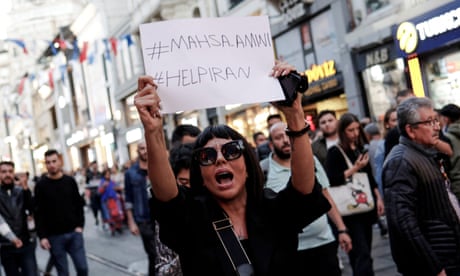- by foxnews
- 08 Apr 2025
Mahsa Amini’s brutal death may be moment of reckoning for Iran
Mahsa Amini’s brutal death may be moment of reckoning for Iran
- by theguardian
- 21 Sep 2022
- in news

Mahsa Amini's death in prison is fast becoming another moment of reckoning for the Iranian regime that fears a popular revolt more than it fears staring down the rest of the world.
Four days after Amini was found dead in a Tehran prison cell, protests in the Iranian capital show little sign of slowing. Most protests appear peaceful, but some in Kurdish areas of Iran have turned violent.
There are some signs that a groundswell could be taking shape: the first of its kind since 2009, when the death of another young woman sparked days of widespread unrest not seen since the Islamic Revolution in 1979.
Even now, Neda Agha Soltan's slow demise from a gunshot to the head remains a testament to how Iran deals with dissent, and with women. Soltan was shot by a sniper as she attended an anti-government protest in June 2009, in a moment that galvanized a revolt and, for a time, exposed the fragility of one of the region's staunchest police states.
Images of Amini being dragged last Thursday into a van by morality police unhappy that she chose not to wear a head scarf have stirred memories of Soltan's death, and once again raised the spectre of a state that routinely commits extreme acts of violence against women and men who defy it.
The decade plus between both events has been an era of increasing oppression in Iran, where activists have been confined to the shadows and the state itself has crushed all trace of the Green Revolution that followed the disputed 2009 presidential elections.
The the state's henchmen, known as basiji, whose members were responsible for killing Soltan, and the Revolutionary Guards, who enforce the values of the Islamic Revolution, have had the run of the streets, especially since the election of Ebrahim Raisi as president.
A hardliner with deeply conservative views, Raisi has further narrowed the margin for dissent, empowering the morality police and entrenching an inflexible interpretation of Shia Islam across all corners of the country.
Iran's leaders have so far blamed "conspirators" for Amini's death even thought it took place in one of the regime's own cells, and also claimed that riots and protests were the work of foes, such as Saudi Arabia. The playbook is familiar, and so too are platitudes.
At the same time, semi-official state media has flagged an inquiry and claimed that senior officials, such as Iran's supreme leader, Ali Khamenei, were likely to have felt sympathy for Amini's death, which had been earlier blamed on a heart condition, or epilepsy, neither of which the 22-year-old Kurd suffered from, according to her parents.
Iran's hardliners have learned lessons from 2009, when a broad uprising nearly escaped the state's control. The country now has some of the best and most pervasive digital security in the region and a firm hold over communities it has terrified into silence.
But it also finds itself up against a formidable expatriate network who want different things for the country and its people, and a strong homegrown activist push that knows how to organise. Whether Amini's death will become another seminal moment in the pursuit of self determination by so many Iranians, or an ember that eventually cools, remains to be seen.
However, Iranian leaders fear a street they can no longer contain. The brutal death of another young woman is the recipe for more unrest. The regime has found itself in tricky waters.
- by foxnews
- descember 09, 2016
Ancient settlement reveals remains of 1,800-year-old dog, baffling experts: 'Preserved quite well'
Archaeologists have recently unearthed the remarkably well-preserved remains of a dog from ancient Rome, shedding light on the widespread practice of ritual sacrifice in antiquity.
read more


